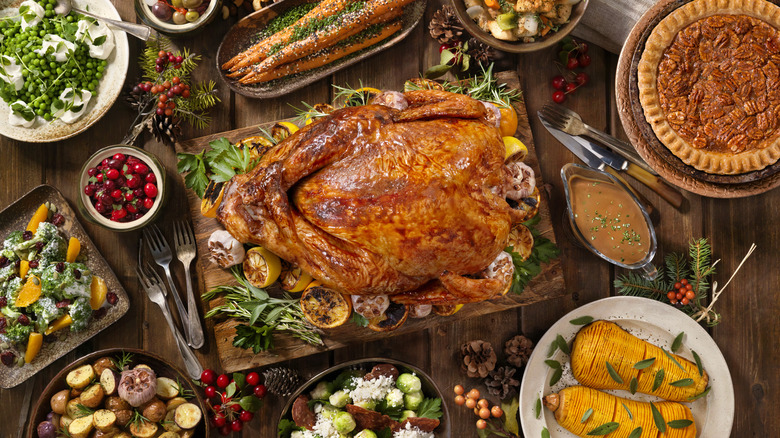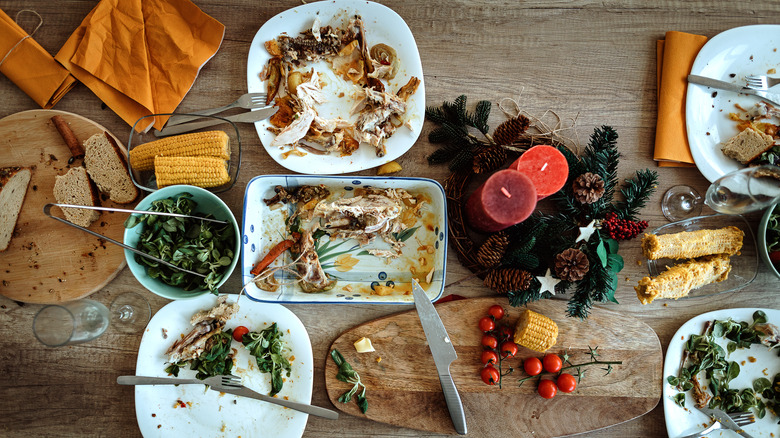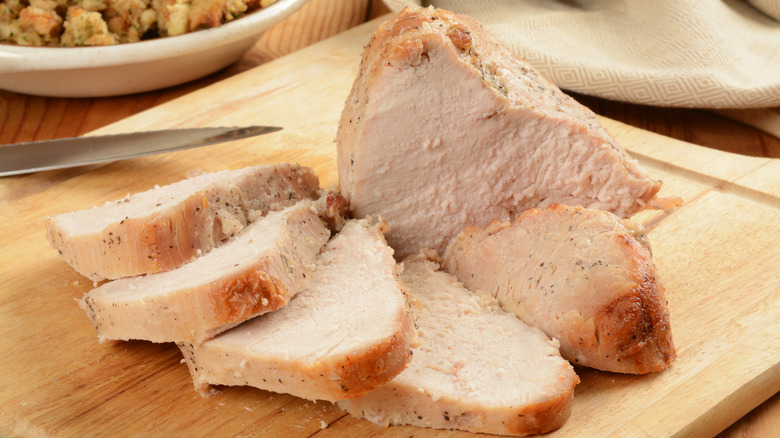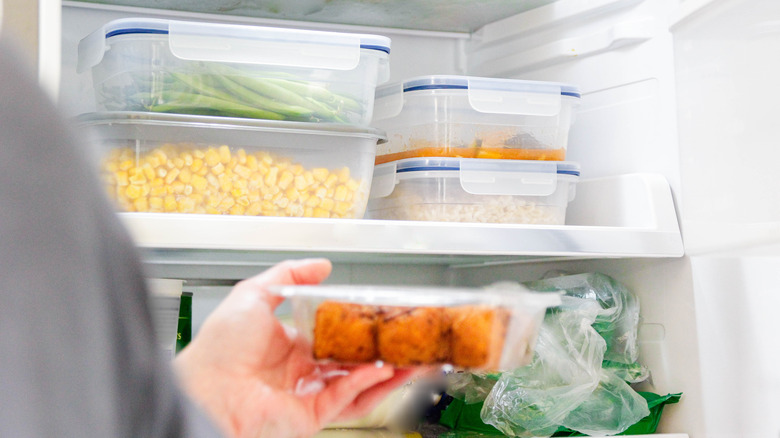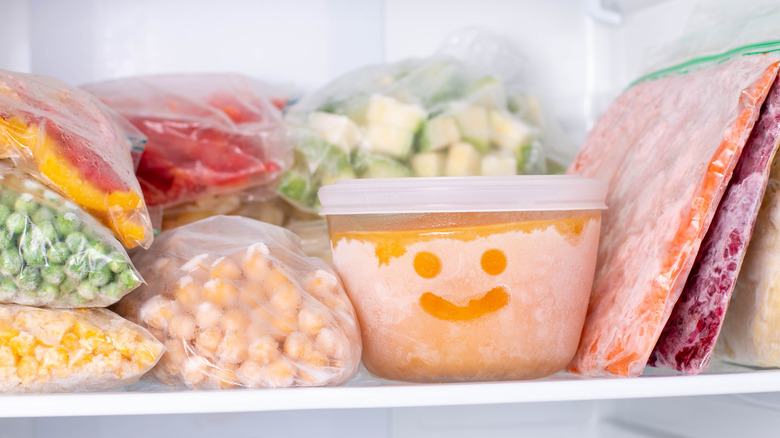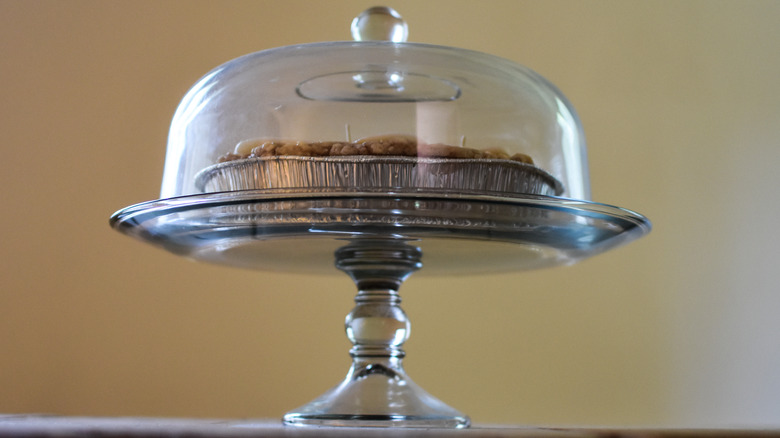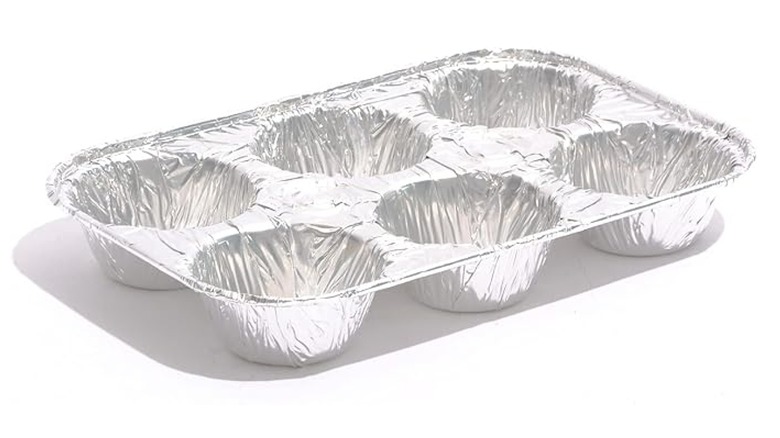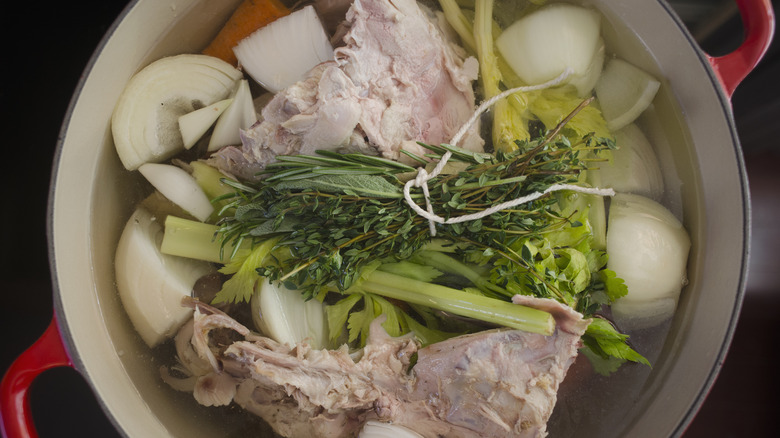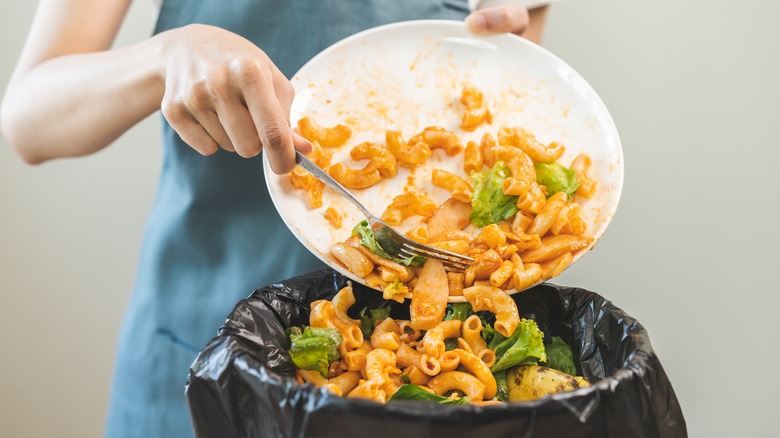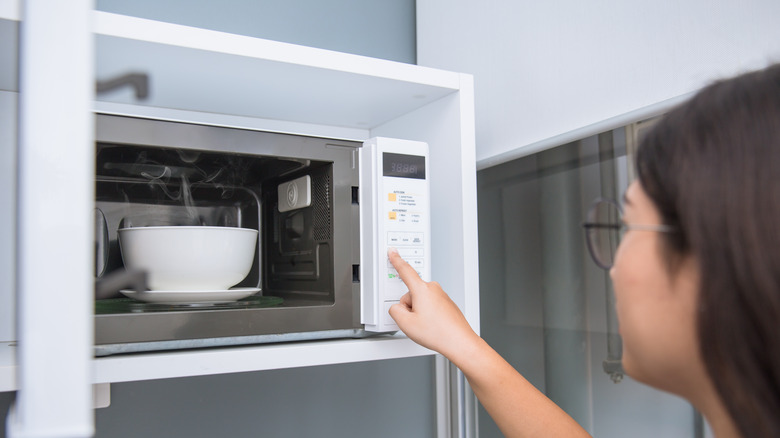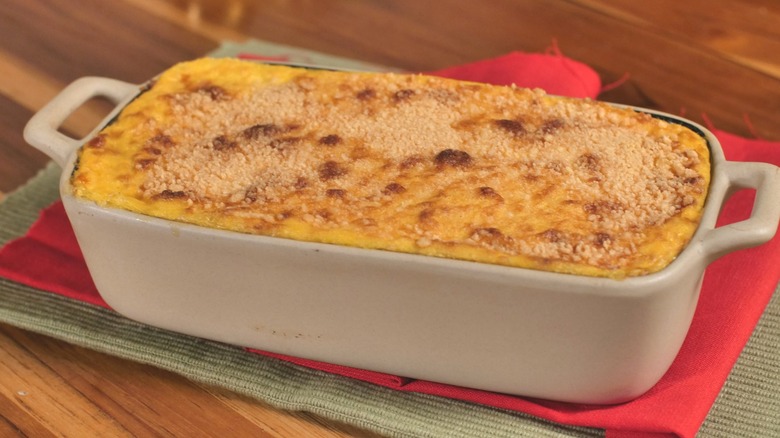10 Mistakes People Make With Thanksgiving Leftovers
We may receive a commission on purchases made from links.
Let's be honest, while food plays a central role in the Thanksgiving festivities, many of us look forward to that first leftover turkey sandwich more than the main meal itself. Repurposing leftovers for several meals is part of the reward of laboring over the initial meal. But, in order to do this safely and deliciously, there are a number of things to keep in mind.
In my nearly two decades as a professional chef, I have prepared countless Thanksgiving day meals. I am always extremely cautious and judicious about how and what I save from the meal. I keep in mind what I learned from the mandatory Food Safety Certification courses I had to take to operate as a food service establishment, and always factor in the creative ways I might be able to use said leftovers.
Sometimes I find it more instructive to educate people about a topic by pointing out the mistakes you can make when executing a task, like handling leftovers. Using these pitfalls as a means of illustrating how to do it better is a great way of committing them to memory so you don't have to think about it on the big day. From storage to reheating to using leftovers, I have all the details you need to keep yourself and your family safe and well-fed for days after the Thanksgiving meal.
1. Mistake: Not putting them away promptly
There is no bigger mistake you can make when it comes to leftovers than allowing them to remain in what food safety experts call the "Danger Zone" for too long before putting them away. The "Danger Zone" is defined by the USDA as the range of temperatures between 40 and 140 degrees F. It is within these parameters that food is highly susceptible to the rapid spread of bacteria, like Salmonella and E. Coli.
What is most important to understand about the "Danger Zone" is how long food can safely remain within it before it should be discarded. The short answer: 2 hours. It can be tempting to allow the turkey and fixings to linger on the dining room table for hours while chatting and watching the game, but every minute that passes is like a ticking time bomb, shortening the life span of your leftovers and making them prime breeding ground for foodborne illnesses.
If you plan to consume any of those precious leftovers beyond Thanksgiving day, you will have to take a pause from the festivities and put them away. I encourage you to make room in the refrigerator in advance so that you don't have to waste any additional time hunting for a place to store them. Not only will that ensure your food remains safe to eat, it will get you back to spending time with friends and family quicker.
2. Mistake: Putting the turkey away whole
While it may be tempting to simply cover the remaining leftover turkey as-is with foil or plastic wrap and throw it into the refrigerator for quick storage, this is ill-advised for a number of reasons. First and foremost, it is dangerous. The interior of the turkey can remain warm, preventing the meat from cooling to a safe internal temperature within the 2-hour window recommended by the USDA, even if it is in the refrigerator. Additionally, it makes it more challenging to access individual portions when you are ready to consume them.
The best way to store turkey is to remove each segment from the carcass and process these into smaller pieces. The breast can be sliced, while the wings, thighs, and drumsticks can be pulled off and stored as individual pieces. These sections can be placed in airtight containers or resealable bags, labeled, and transferred to the refrigerator or freezer for safe keeping. And, don't discard the turkey bones or carcass. It can be transformed into homemade stock. More on that in a bit.
3. Mistake: Failing to store them in airtight containers
If you have ever played refrigerator Jenga — which is also a cool guessing game of trying to determine what mysterious item is in each unmarked container of leftovers — you understand the importance of proper storage. Ideally, leftovers should be stored in airtight containers. Doing so prevents them from spoiling rapidly and from absorbing or spreading aromas throughout the refrigerator.
I tend to favor square, plastic containers in various sizes with tight fitting lids, like those made by Rubbermaid. These are a lot easier to stack in an organized fashion than those that are round. That said, there may be a powerful case for exclusively storing leftovers in resealable bags, especially if you are hurting for adequate storage space. Plastic bags take up a lot less space in the refrigerator than any airtight container. If you are concerned about sustainability, resealable plastic bags can be recycled at participating retailers, though they cannot be placed in your curbside recycling bin. Alternatively, you can purchase reusable, resealable bags, like these dishwasher-safe, silicone ones from Lerine.
Lastly, don't forget to label those leftovers. Proper labeling should include what the item is and the date it was placed in the refrigerator so that you can use them up promptly or discard them when the time comes. The easiest method for labeling is to use masking tape and a Sharpie. These can easily be removed from the container or bag and discarded once you have finished the leftovers.
4. Mistake: Forgoing the freezer for some items
If you are pressed for refrigerator space or do not think you can use all of that leftover turkey before it spoils, you may want to consider freezing it. The freezer is a great option for a number of items, but not all. Salads with raw vegetables, cooked vegetable dishes (like that green bean casserole), chunky soups loaded with grains or potatoes, foods containing corn starch or gelatin, and custard, cream, or mousse pies are all poor candidates for freezing.
Before freezing leftovers, be sure to transfer them into smaller containers to allow them to cool thoroughly. Additionally, make sure the vessel you place them in is freezer safe, whether you are using an airtight container or resealable bag. If using a bag, remove as much of the air from the bag as possible before placing it in the freezer. Again, labeling is key to ensuring you know what the item is, when it was cooked, and when it was placed in the freezer.
Lastly, how you pack the freezer matters. Always place your newest leftovers in the back of the freezer rather than the front to ensure you are using up those that are older first and to prevent freezer burn. Additionally, don't overstuff your freezer. Doing so can prevent proper airflow, causing fluctuations in temperature, which may put your leftovers in danger of becoming contaminated with harmful bacteria due to thawing and refreezing.
5. Mistake: Not knowing which items can be stored at room temperature and how
While most Thanksgiving staples should be stored in the refrigerator for safety and longevity, there are a handful of items that can be kept at room temperature. Fresh bread and rolls last longer when not refrigerated. When bread is refrigerated, the starches within it can begin to crystallize, dehydrating it and making it stale. It will thrive for a longer period of time when wrapped in a paper bag and kept in a cool, dry place with decent airflow.
The other items that can be stored safely at room temperature are fruit-based pies. Because there is no dairy or eggs in a fruit pie, they are not as perishable. And, storing a fruit pie at room temperature will ensure the crust retains its flaky texture rather than becoming dried out and dense. When storing a pie at room temperature, make sure to keep it in a cool, dry place, away from direct sunlight. While you can wrap it in foil or plastic, I prefer placing it on a cake stand and covering it with a pie dome.
The one caveat to storing bread or fruit pies at room temperature is if you live in a very warm, humid climate. High humidity and heat can cause mold to form more rapidly and expedite spoilage. Unless you use a dehumidifier and can maintain a consistent, cool temperature in your kitchen, you may opt to freeze both to extend their shelf-life.
6. Mistake: Forgetting to give away doggie bags
According to the U.S.-based non-profit organization ReFED, Americans waste approximately 312 million pounds of food on Thanksgiving. Not only does this waste contribute to pollution, it represents an enormous economic loss. One way to combat this is to help spread the wealth by dividing up leftovers and giving some of them to guests. Everyone loves a "doggie bag," but sometimes getting leftovers from the Thanksgiving table to your home refrigerator can be a challenge. Developing methods that simplify the distribution of leftovers is the key to both eliminating waste and showing your friends and family you care.
If you are a guest attending a Thanksgiving day feast, you may want to bring your own to-go containers or reusable, resealable bags to the event to streamline the process of packing up leftovers. That said, there is a hack that you might want to use that is easy, cheap, and even makes reheating leftovers a cinch — disposable muffin tins. Disposable muffin tins enable you to pack up leftovers while keeping them separated, and they allow you to put the leftovers straight into the oven to reheat without the need to transfer them to a different baking dish or pan.
Muffin tins can be purchased in bulk on Amazon and laid out for guests in attendance to bag up their own leftovers. It is always a good idea to allow guests to decide for themselves what they think they will eat rather than doing so for them.
7. Mistake: Not saving the turkey bones to make stock
One relatively simple, yet incredibly effective, way of using up the leftover carcass from your Thanksgiving turkey is to turn it into stock for your homemade soup or stew. Once you have removed as much meat from the carcass as you can, the bones can easily be transformed with some aromatics, herbs, and water in a matter of hours.
The key lies in the collagen built up in the bones of the turkey. As these slow cook, they will yield a nutritious and delicious stock. To add more richness and depth of flavor to homemade stock, place the turkey remnants on a baking sheet and roast them for a spell before combining them with onions, celery, carrots, and dried herbs. And, whatever you do, use a measured hand when seasoning your stock. While most stock recipes call for salt to be added to the cooking liquid, you may want to hold off on adding any until the end, as the turkey carcass will likely already have enough seasoning to give the finished product plenty of flavor.
To further enhance the flavor of homemade turkey stock, try adding umami-rich ingredients, like mushrooms or tomato paste. These will amplify the inherent savoriness of the turkey bones while giving the stock a deeper hue and more luxurious mouthfeel.
8. Mistake: Not disposing of leftovers in a timely fashion
While saving leftovers is a good way to combat food waste, at some point you have to say goodbye to them. A basic rule of thumb to keep in mind is the 2-2-2 guideline. This easy-to-remember rule reminds us to put leftovers in the refrigerator within two hours of cooking them, consume or freeze them within two days of refrigerating them, and discard them after two months in the freezer. While these are basic guidelines that may not apply universally to every food item, they are a good way to minimize the potential of becoming ill.
That said, it is helpful to know exactly which foods might last longer than two days. Generally speaking, turkey, stuffing, casseroles, and even that custard-y pumpkin pie can last for up to four days, while some dishes, like cranberry sauce and fruit pies, can last longer if properly stored. It is always a good idea to check before you eat something and discard it if you aren't sure.
When discarding leftovers, it may be tempting to add these to the compost heap, but this is not necessarily a good idea. Many items, like leftover turkey, dairy, and anything prepared with fat, can contaminate the compost heap and attract pests. It is best to reserve the composting for the preparation phase of the meal, only adding raw fruit and vegetable scraps, eggshells, tea bags, and coffee grinds to the heap.
9. Mistake: Failing to reheat them thoroughly
While safely storing leftovers is important, reheating them to a safe minimum internal temperature of 165 degrees F is even more critical to preventing the spread of foodborne illnesses. There are a number of ways you can reheat Thanksgiving leftovers safely and effectively. While the microwave, oven, or stovetop are all good methods for reheating leftovers, the air fryer may be the best way to resuscitate that turkey without drying it out. Just be sure to add a protective layer to the meat by either drizzling it with some oil or wrapping it in aluminum foil to seal in those juices.
When it comes to how not to reheat leftovers, the crock pot is a big no-no. That said, you can repurpose leftovers in the appliance if they are reheated to 165 degrees F first and then transferred to the slow cooker for further cooking. Another thing to keep in mind is the importance of safely thawing frozen items before reheating. It is never a good idea to set frozen leftovers on the countertop and allow them to thaw there. They should always be transferred to the refrigerator overnight before they are reheated.
10. Mistake: Failing to get creative with recipes
We all crave variety, even if we don't want to waste Thanksgiving leftovers. The good news is that there are many creative ways to use these beyond soups and sandwiches. Certainly casseroles, stews, and chilis are easy and tasty recipes to toss that turkey or creamed corn into, but with just a hint more effort, you can level up leftovers into something unique and even elegant.
One of my favorite ways of transforming leftovers is to make them into fritters. These tiny patties can be made using leftover corn, stuffing, turkey, and even macaroni and cheese. Simply fry them up and serve them with a creative dipping sauce for a savory appetizer or crispy side dish. Another great option that will serve as more of an entrée option is to toss all of your favorite leftovers into a loaf pan and bake it up. This play on meatloaf can be sliced and served as-is or alongside a simple green salad. And, if you enjoy a chicken pot pie, take those Thanksgiving scraps and pop them between two layers of store-bought pie crust for a quick and easy entrée that is sure to wow your family.
Lastly, Thanksgiving leftovers aren't just for lunch or dinner. There is nothing easier than adding them to eggs to create a hearty breakfast casserole, frittata, or quiche that will perk up the taste buds of even the grumpiest morning person.
